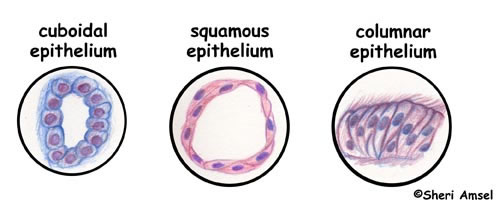

Epithelial Tissue Functions (jobs):
Epithelial Tissue Characteristics (Traits):
1. Epithelial cells are closely attached to each other (especially compared to muscles and connective tissue). This forms a protective barrier.
2. Epithelium always has a free surface (apical surface) that is exposed to the body’s exterior or the empty cavity of an internal organ.
Epithelium also always has a bound region (basal) attached to the underlying connective tissue. There is a thin adhesive (sticky) margin between the epithelial cells and the connective tissue call the basement membrane. The basement membrane is not a true membrane, as such, but is made up of two sticky layers: a basal lamina (epithelial layer) and a reticular lamina (connective tissue layer).
3. Epithelium has no blood vessels in it but absorbs nutrients from blood vessels in the underlying connective tissue.
4. Epithelium can be highly innervated (lots of nerves endings).
5. Epithelium is highly regenerative (repairing itself) i.e. scraped knee, peeling sunburn.
Classification of Epithelial Tissue (types):
1) Classification by shape: 3 common shapes of Epithelial Cells:
a) squamous - flat and scale-like
b) cuboidal - as tall as they are wide
c) columnar - tall, column-shaped
2) Classification by Cell Arrangement: 2 major varieties of epithelium:
a) simple epithelium - single layer of cells (usually for absorption and filtration)
b) stratified epithelium - stacked up cell layers (protection from abrasion - mouth, skin.)
There is also pseudostratified epithelium - looks like stacked cell layers, but is actually a single layer of cells (trachea and upper respiratory tract, it secretes mucus and its cilia helps to propel foreign material out of the body through coughing).
Defining Epithelial Tissue by Cell Shape and Arrangement
l. Simple Squamous Epithelium
• A single layer of thin flat cells, irregular in shape
• They are thin and permeable, though arranged like a tight, tile floor
• They are a slick, friction free lining for blood vessels and lymphatic vessels
Location and Function:
1) Capillary walls between blood and tissues - so thin they are ideal for nutrient exchange
2) Kidneys - good for filtration
3) Lung air sacs (alveoli) - good for gas exchange
4) Peritoneum (mesothelium - serous membranes lining ventral cavity)
ll. Simple Cuboidal Epithelium
• A single layer of cuboidal cells
• For secretion and absorption
Location and Function:
1) Glands - forms both the secretions and the ducts to deliver them, i.e. kidneys, ovaries, etc.
lll. Simple Columnar Epithelium
• A single layer of closely packed columnar cells
Location and Function:
1) Digestive Tract - for absorption and secretion. The simple columnar epithelium of the digestive tract has microvilli on the surface that increases the surface area of each cell for absorption of nutrients. This is called simple columnar ciliated epithelium. (They contain goblets cells that secrete a glycoprotein mucus that acts as a protective lubricant.)
2) Respiratory Tract - also simple columnar ciliated epithelium for moving foreign objects out of the trachea and bronchi.
3) Uterus and Oviducts - have simple columnar ciliated epithelium for moving egg along.
lV. Pseudostratified Columnar Epithelium
• A single layer of cells, but though all rest on the basement membrane, some are shorter than others and may not reach the surface of the cell layer.
• They are often ciliated
Location and Function:
1) Lungs - they contain goblets cells that secrete a glycoprotein mucus that traps inhales dust and the cilia propel it away from the lungs.
2) Large glands
3) Urethra (males)
V. Stratified Squamous Epithelium
• Two or more cell layers
• Found in areas exposed to wear and tear
• The free cells are squamous, but the deeper cells can be cuboidal or sometimes columnar.
Location and Function:
1) Lines the tongue, mouth, pharynx, esophagus, anal canal and vagina - protection from abrasion
2) Epidermis (Skin) - protection from abrasion, dehydration, etc.
Vl. Stratified Cuboidal Epithelium
• Usually only two call layers thick
• Not that common in the body
Location and Function:
1) Sweat gland ducts, mammary glands and salivary glands - protection
Vll. Stratified Columnar Epithelium
• Only the free layer is columnar, deeper cells are cuboidal or irregular
• Rare
• May have Goblet cells
Location and Function:
1 ) Some glands and ducts (i.e. male urethra) - protection and secretion
Vlll. Transitional Epithelium
• Unique - has the ability to stretch
• Cells on the free surface may look cuboidal (with more than one nucleus), but as they stretch, they look more squamous
• Deeper basal layer of cells are cuboidal or columnar
Location and Function:
1) Bladder, kidneys, ureters - allows urinary tract to fill and empty with urine
Epithelial Membranes
There are 3 types of Epithelial Membranes: Mucous, Cutaneous and Serous. All are made up of a multicellular sheet of epithelium stuck to connective tissue layer. This is called the: Lamina Propria
Mucous Membranes (Mucosae):
1) Line body cavities that are open to the outside world
(i.e. digestive, respiratory, urogenital tracts)
2) Are wet, moist membrane with lots of secretions
3) Cell type varies, but mostly simple columnar epithelium
4) Adapted for absorption and secretion
Cutaneous Membranes:
1) Skin
2) Keratinized stratified squamous epithelium (epidermis) attached to a thick connective tissue layer (dermis).
3) Dry membrane
Serous Membranes (Serosae):
1) Moist membranes found in closed ventral body cavities (parietal and visceral layers)
2) Each consist of simple squamous epithelium resting on a small amount of loose connective tissue.
3) Serous fluid lubricates parietal and visceral layers so they slide across each other easily.
4) Named for organs, i.e. pleura (lungs), pericardium (heart), peritoneums (abdominopelvic cavity organs).



